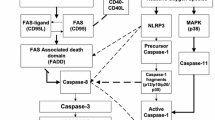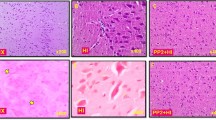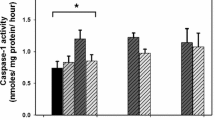Abstract
The present study aims to investigate the mechanism of CaM kinase IV activation during hypoxia and tests the hypothesis that hypoxia-induced increased activity of CaM kinase IV is due to Src kinase mediated increased tyrosine phosphorylation of calmodulin and CaM kinase IV in neuronal nuclei of the cerebral cortex of newborn piglets. Piglets were divided into normoxic (Nx, n = 5), hypoxic (Hx, FiO2 of 0.07 for 1 h, n = 5) and hypoxic-pretreated with Src kinase inhibitor PP2 (Hx-Srci, n = 5) groups. Src inhibitor was administered (1.0 mg/kg, I.V.) 30 min prior to hypoxia. Neuronal nuclei were isolated and purified, and tyrosine phosphorylation of calmodulin (Tyr99) and CaM kinase IV determined by Western blot using anti-phospho-(pTyr99)-calmodulin, anti-pTyrosine and anti-CaM kinase IV antibodies. The activity of CaM kinase IV and its consequence the phosphorylation of CREB protein at Ser133 were determined. Hypoxia resulted in increased tyrosine phosphorylation of calmodulin at Tyr99, tyrosine phosphorylation of CaM kinase IV, activity of CaM kinase IV and phosphorylation of CREB protein at Ser133. The data show that administration of Src kinase inhibitor PP2 prevented the hypoxia-induced increased tyrosine phosphorylation of calmodulin (Tyr99) and tyrosine phosphorylation of CaM.kinase IV as well as the activity of CaM kinase IV and CREB phosphorylation at Ser133. We conclude that the mechanism of hypoxia-induced increased activation of CaM kinase IV is mediated by Src kinase-dependent tyrosine phosphorylation of the enzyme and its activator calmodulin. We propose that Tyr99 phosphorylated calmodulin, as compared to non-phosphorylated, binds with a higher affinity at the calmodulin binding site (rich in basic amino acids) of CaM kinase IV leading to increased activation of CaM kinase IV. Similarly, tyrosine phosphorylated CaM kinase IV binds its substrate with a higher affinity and thus increased tyrosine phosphorylation leads to increased activation of CaM kinase IV resulting in increased CREB phosphorylation that triggers increased transcription of proapoptotic proteins that initiate hypoxic neuronal death.




Similar content being viewed by others
References
Zubrow AB, Delivoria-Papadopoulos M, Ashraf QM, Fritz KI, Mishra OP (2002) Nitric oxide-mediated Ca2+/calmodulin-dependent protein kinase IV activity during hypoxia in neuronal nuclei from newborn piglets. Neurosci Lett 335:5–8
Chin D, Means AR (2000) Calmodulin: a prototypical calcium sensor. Trends Cell Biol 10:32
Babu YS, Sack JS, Greenhough TJ, Buge CE, Means AR, Cook WJ (1985) Three-dimensional structure of calmodulin. Nature 315:37–40
Vorherr T, Knopfel L, Hofmann F, Mollner S, Pfeuffer T, Carafoli E (1993) The calmodulin binding domain of nitric oxide synthase and adenyl cyclase. Biochemistry 32:6081–6088
Benaim G, Villalobo A (2002) Phosphorylation of calmodulin. Eur J Biochem 269:3619–3631
Benguria A, Hernandez-Perera O, Martinez-Pastor MT, Sacks DB, Villalobo A (1998) Phosphorylation of calmodulin by the epidermal-growth-factor-receptor tyrosine kinase. Eur J Biochem 224:909–916
Benaim G, Cervino V, Villalobo A (1998) Comparative phosphorylation of calmodulin from trypanosomatids and bovine brain by calmodulin-binding protein kinases. Comp Biochem Physiol Part C 120:57–65
Palomo-Jimenez PI, Hernandez-Hernando S, Garcia-Nieto RM, Villalobo A (1999) A method for the purification of phospho(Tyr)calmodulin free of non-phosphorylated calmodulin. Prot Exp Purif 16:388–395
Soderling TR (1999) The Ca-calmodulin-dependent protein kinase cascade. Trends Biochem Sci 24:232–236
Mathews RP, Guthrie CR, Wailes LM, Zhao X, Means AR, McKnight GS (1994) Calcium/calmodulin-dependent protein kinase types II and IV differently regulate CREB-dependent gene expression. Mol Cell Biol 14:6107–6116
Watanabe S, Okuno S, Kitani T, Fujisawa H (1996) Inactivation of calmodulin-dependent protein kinase IV by autophosphorylation of serine 332 within the putative calmodulin-binding domain. J Biol Chem 271:6903–6910
Hardingham GE, Arnold FJ, Bading H (2001) Nuclear calcium signaling controls CREB-mediated gene expression triggered by synaptic activity. Nat Neurosci 4:261–267
Mishra OP, Ashraf QM, Delivoria-Papadopoulos M (2002) Phosphorylation of cAMP response element binding (CREB) protein during hypoxia in cerebral cortex of newborn piglets and the effect of nitric oxide synthase inhibition. Neuroscience 115:985–991
Giufrida AM, Cox D, Mathias AP (1975) RNA polymerase activity in various classes of nuclei from different regions of rat brain during postnatal development. J Neurochem Res 26:821–827
Lowry O, Rosenbrough NJ, Farr A, Randall RJ (1951) Protein measurement with Folin phenol reagent. J Biol Chem 193:265–275
Park IK, Soderling TR (1995) Activation of Ca2+/calmodulin-dependent protein kinase (CaM-kinase) IV by CaM-kinase kinase in jurkat T lymphocytes. J Biol Chem 270:30464–30469
Lamprecht W, Stein P, Heinz F, Weissner H (1974) Creatine phosphate. In: Bergmeyer HU (ed) Methods of enzymatic analysis, vol 4. Academic Press, New York, pp 1777–1781
Mishra OP, Delivoria-Papadopoulos M (2002) Nitric oxide-mediated Ca++-influx in neuronal nuclei and cortical synaptosomes of normoxic and hypoxic newborn piglets. Neurosci Lett 318:93–97
Delivoria-Papadopoulos M, Akhter WA, Mishra OP (2003) Hypoxia-induced Ca++-influx in cerebral cortical neuronal nuclei of newborn piglets. Neurosci Lett 342:119–123
Zubrow AB, Delivoria-Papadopoulos M, Ashraf QM, Ballesteros JR, Fritz KI, Mishra OP (2002) Nitric oxide-mediated expression of Bax protein and DNA fragmentation during hypoxia in neuronal nuclei from newborn piglets. Brain Res 954:60–67
Mishra OP, Zanelli S, Ohnishi ST, Delivoria-Papadopoulos M (2000) Hypoxia-induced generation of nitric oxide free radicals in cerebral cortex of newborn guinea pigs. Neurochem Res 25:1559–1565
Barret WC, Degnore JP, Keng YF, Zang ZY, Yim MB, Chock PB (1999) Roles of superoxide radical anion in signal transduction mediated by reversible regulation of protein-tyrosine phosphatase IB. J Biol Chem 49:34543–34546
Lee SR, Kwan KS, Kim SR, Rhu SA (1988) Reversible inactivation of protein-tyrosine phosphatase IB in A431 cells stimulated with epidermal growth factor. J Biol Chem 273:15366–15372
Takakure K, Beckman JS, MacMillan-Cron LA, Cron JP (1999) Rapid and irreversible inactivation of protein tyrosine phosphatases PTPIB, CD45 and LAR by peroxynitrite. Arch Biochem Biophys 369:197–207
Beckman JS, Beckman TW, Chen J, Marshall PA, Freeman BA (1990) Apparent hydroxyl radical by peroxynitrite: implications for enthothelial injury from nitric oxide and superoxide. Proc Natl Acad Sci 87:1620–1624
Ischiropoulos H, Zhu L, Beckman JS (1992) Peroxynitrite formation from macrophage-derived nitric oxide. Arch Biochem Biophys 298:446–451
Zanelli S, Ashraf QM, Mishra OP (2002) Nitration is a mechanism of regulation of the NMDA receptor function during hypoxia. Neurosci Lett 112:869–877
Hunter T (1995) Protein kinases and phosphatases: the Yin and Yang of protein phosphorylation and signaling. Cell 80:225–236
King HJ, Chen HC, Robinson D (1988) Molecular profiling of tyrosine kinases in normal and cancer cells. J Biomed Sci 5:74–78
Lin WC (2003) Protein tyrosine kinase and phosphatase expression profiling in human cancers. Methods Mol Biol 218:113–125
Johnson GL, Lapadat R (2004) Mitogen activated protein kinase pathways mediated by ERK, JNK and p38 protein kinases. Science 298:1911–1912
Nobel MEM, Endicott JA, Johnson LN (2004) Protein kinase inhibitors: insights into drug design from structure. Science 303:1800–1805
Alanso A, Sasin J, Bottini N, Friedberg I, Osterman A, Godzik A, Hunter T, Dixon J, Mustalin T (2004) Protein tyrosine phosphatases in human genome. Cell 117:699–711
Manning G, Whyte DB, Martinez R, Hunter T, Sudarsanam S (2002) The protein kinase complement of the human genome. Science 298:1912–1934
Nathoo N, Goldlust S, Vogelbaum MA (2004) Epidermal growth factor receptor anagonists: novel therapy for the treatment of high-grade gliomas. Neurosurgery 54:1480–1489
Liu B, Neufeld AH (2007) Activation of epidermal growth factor receptors in astrocytes: from development to neural injury. J Neurosci Res 85:3523–3529
Contessa JN, Hamstra DA (2008) Revoking the privilege: targeting HER2 in the central nervous system. Mol Phamacol 73:271–273
Cameron DA, Stein S (2008) Drug insight: intracellular inhibitors of HER2-clinical development of lapatinib in breast cancer. Nat Clin Pract Oncol 5:512–520
Sharma PS, Sharma R, Tyagi T (2009) Receptor tyrosine kinase inhibitors as potent weapons in war against cancers. Curr Pharm Res 15:758–776
Mishra OP, Ashraf QM, Delivoria-Papadopoulos M (2009) NO-mediated activation of Src kinase during hypoxia in the cerebral cortex of newborn piglets. Neurosci Lett 460:61–65
Mishra OP, Ashraf QM, Delivoria-Papadopoulos M (2010) Hypoxia-induced activation of epidermal growth factor receptor(EGFR) kinase in the cerebral cortex of newborn piglets: the role of nitric oxide. Neurochem Res 35(9):1471–1477
Colomer J, Means AR (2007) Physiological roles of the Ca2+/CaM-dependent protein kinase cascade in health and disease. Subcell Biochem 45:169–214
Racioppi L, Means AR (2008) Calcium/calmodulin-dependent kinase IV in immune and inflammatory responses: novel routes for an ancient traveler. Trends Immunol 12:600–607
Acknowledgments
This study was supported by the National Institute of Health grants HD-20337. The authors thank Ms. Anli Zhu and Miss Hien Pham for their expert technical assistance.
Author information
Authors and Affiliations
Corresponding author
Rights and permissions
About this article
Cite this article
Delivoria-Papadopoulos, M., Ashraf, Q.M. & Mishra, O.P. Mechanism of CaM Kinase IV Activation During Hypoxia in Neuronal Nuclei of the Cerebral Cortex of Newborn Piglets: The Role of Src Kinase. Neurochem Res 36, 1512–1519 (2011). https://doi.org/10.1007/s11064-011-0477-3
Accepted:
Published:
Issue Date:
DOI: https://doi.org/10.1007/s11064-011-0477-3




